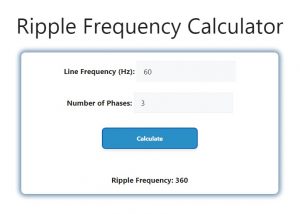About Ripple Frequency Calculator (Formula)
The Ripple Frequency Calculator is a useful tool for understanding the performance of electrical systems, especially in power supply design. Ripple frequency refers to the variation in the output voltage of a power supply, often resulting from the rectification process. This calculator enables engineers and technicians to compute the ripple frequency based on the line frequency and the number of phases in a system. Understanding ripple frequency is crucial for ensuring the stability and efficiency of power supplies, which are integral components in various electronic devices.
Formula
The formula to calculate the ripple frequency is:
Ripple Frequency (RF) = 2 * Line Frequency (LF) * Number of Phases (P)
This formula takes into account the line frequency in hertz and the number of phases in the electrical system, multiplying them to derive the ripple frequency.
How to Use
Using the Ripple Frequency Calculator is straightforward. Follow these steps:
- Input Line Frequency: Enter the line frequency in hertz (Hz). This is typically the frequency of the AC power supply in your region (e.g., 50 Hz or 60 Hz).
- Input Number of Phases: Specify the number of phases in your electrical system. Common configurations include single-phase (1) or three-phase (3).
- Calculate Ripple Frequency: Click the “Calculate” button to find the ripple frequency for your specific inputs.
- Review Results: The calculator will display the calculated ripple frequency, which can be used for further analysis of the electrical system.
Example
Let’s consider an example for clarity:
- Line Frequency (LF): 60 Hz
- Number of Phases (P): 3
Using the formula:
Ripple Frequency (RF) = 2 * 60 * 3
Ripple Frequency (RF) = 360 Hz
In this case, the ripple frequency for a system with a line frequency of 60 Hz and three phases would be 360 Hz.

FAQs
1. What is ripple frequency?
Ripple frequency is the frequency of the voltage variation in a power supply output, typically caused by the rectification process.
2. Why is ripple frequency important?
It helps in determining the stability of power supplies and their ability to maintain a consistent voltage output.
3. How do I find the line frequency for my area?
Line frequency varies by region; most of North America uses 60 Hz, while many countries use 50 Hz.
4. Can ripple frequency affect device performance?
Yes, excessive ripple frequency can lead to voltage fluctuations, which may affect the performance of sensitive electronic devices.
5. Is the ripple frequency the same as the line frequency?
No, ripple frequency is derived from the line frequency and is typically higher than the line frequency itself.
6. What is the typical ripple frequency for a single-phase system?
For a single-phase system, the ripple frequency is double the line frequency (e.g., 120 Hz for a 60 Hz line frequency).
7. How can I reduce ripple frequency in a power supply?
Implementing better filtering techniques, such as capacitors and inductors, can help reduce ripple frequency.
8. What role does the number of phases play in ripple frequency?
The number of phases directly influences the ripple frequency; more phases typically lead to higher ripple frequencies.
9. Can ripple frequency be measured?
Yes, ripple frequency can be measured using an oscilloscope or a frequency meter.
10. Does ripple frequency affect power supply efficiency?
Yes, a high ripple frequency can indicate inefficiencies in the power supply design, potentially leading to higher energy losses.
11. Is ripple frequency the same in all electrical systems?
No, ripple frequency varies based on the line frequency and the number of phases used in the electrical system.
12. How often should ripple frequency be checked in power supplies?
It’s advisable to check ripple frequency regularly, especially during maintenance checks or after significant modifications to the system.
13. What is the difference between ripple frequency and hum?
Ripple frequency refers to voltage variations due to power supply rectification, while hum typically refers to unwanted audio frequencies caused by electromagnetic interference.
14. Can ripple frequency impact battery life?
Yes, if ripple frequency leads to voltage fluctuations, it can adversely affect battery charging and discharging cycles.
15. Are there industry standards for acceptable ripple frequency?
Yes, various standards exist depending on the application, and manufacturers usually specify acceptable levels for their products.
16. How does ripple frequency relate to power factor?
Ripple frequency does not directly affect power factor, but it can influence the overall efficiency and performance of the electrical system.
17. What tools can be used to calculate ripple frequency?
You can use calculators specifically designed for ripple frequency, software tools, or manual calculations based on the provided formula.
18. Can ripple frequency calculations help in designing power supplies?
Yes, understanding ripple frequency is critical for designing efficient and stable power supply systems.
19. How does temperature affect ripple frequency?
Temperature can influence the electrical characteristics of components, potentially affecting the ripple frequency.
20. What happens if ripple frequency is too high?
A high ripple frequency can cause excessive heating, reduced efficiency, and possible damage to electronic components.
Conclusion
The Ripple Frequency Calculator is a vital tool for engineers and technicians working with electrical systems. By calculating the ripple frequency based on line frequency and the number of phases, users can gain insights into the stability and efficiency of power supplies. Understanding and managing ripple frequency is essential for ensuring the reliability of electronic devices and overall system performance. With this knowledge, you can make informed decisions about the design and operation of electrical systems, ultimately leading to better performance and longevity.
